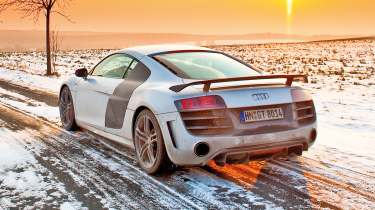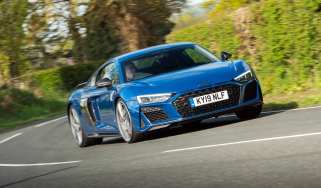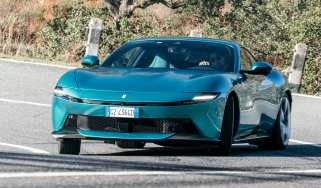Audi R8 GT to the Grossdeutschlandring
In the 1930s, Nazi Germany built the ultimate racetrack, with predicted average lap speeds of 100mph and the fastest corner ever seen. But the outbreak of war meant races would never be held at the Grossdeutschlandring – officially. David Vivian braves -17°C in an Audi R8 GT to find Hitler’s lost circuit
ALTHOUGH I like a cool, crisp Tuesday morning as much as the next airline traveller, this one’s a bit of a shocker. Despite what would normally be the reassuring crunch of grit underfoot, the vast sunken courtyard of Munich Airport’s Terminal 2 is so cold that the authorities have laid a network of springy rubber matting to walk on. It branches out from the terminal doors, converging again towards the lifts and escalators at the far end. The space is bisected by a horizontal plane of short-lived miniature clouds as puffs of moist breath condense in the glistening air. People who’ve stopped to sip from cardboard coffee-cups appear to be gently smouldering.
While photographer Dave Smith and I acquaint our pile of bags with a low-loader trolley like men slowly succumbing to paralysis, we speculate a) just how many degrees below zero it could be, b) whether we should trust the ‘extreme cold but no snow’ forecast for the rest of the week, c) whether an Audi R8 GT is going to make it to the nearest Autobahn rest-stop, let alone the small town of Hohnstein just south of Dresden some 370 even colder miles away, and d) assuming it does, if we’ll ever get back.
We settle on the reasonably cheerful thought that rather than having to take a ruinously expensive taxi-ride to the Audi factory in Ingolstadt, the R8 is waiting for us at Audi’s thoughtfully located Forum conference centre, but a short trip up the escalator or, in Dave and the trolley’s case, the lift – a contraption I avoid getting into whenever possible, even a German one.
The key and document pack are handed over with a very stern piece of advice from the man standing behind an astonishingly minimalist arc of desk in the even more sparsely functional reception area. ‘You must be very, very careful,’ he intones, placing extra emphasis on the verys, ‘because this is not an easy car to drive in these conditions.’ No kidding. ‘And I must apologise for the state of the car,’ he adds. ‘We haven’t been able to wash it as the car washes are frozen.’
He really isn’t kidding. The R8 GT isn’t so much dirty as en croute, hidden beneath a crust of finely blended road salt and grunge. Interestingly, its pale grey paintwork has a matt finish, which would be cool were it not for the fact that all the cars in the vicinity have a salty matt finish too. And most of them look quite grey. Still, although Munich has obviously had its fair share of fluffy white stuff, not much of it has been allowed to linger on the roads (or, thankfully, the runways, though I swear our Lufthansa Airbus 312 pilot had to wrap on an armful of opposite lock to keep us out of the shopping mall as we touched down).
Hazy blue skies should lift our mood further, but the faff factor ratchets up a couple of levels when we realise the uber-butch-looking four-point harnesses (admittedly, a welcome splash of red amid the unremitting grey-white wash) aren’t supplemented by conventional inertia reels. When I rouse the 5.2-litre V10’s 552 horses, the temperature display shows an all-too-believable minus 11 Celsius.
Wrapped in padded ski jackets and wedged into the fixed-backrest carbon bucket seats, Dave and I sit for a few minutes and listen to the bassy, grumbly idle of the engine, not least on my pretext that the R8’s aluminium gearknob is too cold to touch, though it does bear the rather impressive inscription signifying that this is GT number 000 of 333. Dave takes a picture of it.
Soon, the miracle of internal combustion has flooded the snug cabin with a cosy warmth we haven’t experienced for many hours. I nudge the now merely freezing gear selector to the left to engage the R-tronic transmission’s Auto mode and gingerly, very gingerly, we head towards the Autobahn and an appointment with the greatest racetrack ever made.
YOU’LL NO DOUBT be delighted, if a little surprised, to hear that it isn’t the Green Hell. We love the Nürburgring to bits and if we fancied the R8 any more we’d have to buy it a box of chocolates and a ticket to a West End show, but together again? Enough already. No, try the Ring that Germany’s Nazi government built in picturesque, cultured Saxony specifically to kick the Nordschleife into touch. The Ring that was forced to fruition over five years with all the ruthless momentum a Nazi vanity project could muster. The Ring incorporating a fabulous old hill climb that snaked skywards from the bottom of a wooded gorge near the town of Hohnstein and combined this with the fastest corner anyone had ever seen. The Ring with room for a million spectators and parking for 350,000 Volkswagens. One Ring intended to rule them all. They called it simply Grossdeutschlandring.
I’ve got to level with you: until recently I’d never heard of it. But then its memory isn’t exactly celebrated in Germany. Today, it exists exactly as it was built but as part of the public road network, its history recorded in the context of Nazi hubris and subsequent Soviet rule rather than motor racing’s greatest lost opportunity. Its 6.2 miles were completed 73 years ago, just in time to become the venue for the 1940 German Grand Prix, with Mercedes team boss Alfred Neubauer practically beside himself at the prospect of 100mph average speeds and nearly 180mph along the 1.06-mile start/finish straight leading into that impossibly fast, slightly banked right-hander. But the Grossdeutschlandring never did host the Grand Prix, which was cancelled, or any officially sanctioned race. The Second World War stopped it in its tracks.
There were races, though. The kind that inevitably materialise, when conditions allow, to exploit an untapped potential. After Germany’s reunification in 1990, the East’s newfound prosperity furnished locals with the means to purchase the kind of two- and four-wheeled performance machinery that would have given Hermann Lang’s Mercedes W165 a run for its money. Competition to post the fastest lap time was fierce, much hinging on the balls-out bravery of the participants and the firmness of their brake pedals on the downhill plunge through the woods back to the bottom of the Polenz gorge. Sometimes, neither was enough. There were crashes, there were deaths and, eventually, there were ‘traffic calming’ chicanes and speed traps on what had become the most notoriously dangerous section of the ‘track’.
I can’t help wondering what it will be like if, as seems increasingly likely, Europe’s coldest snap in years has turned it into a toboggan run. In an Audi R8 GT.
OF COURSE, the Audi is wearing a fine set of winter tyres. It feels unexpectedly on-side, too, a tentative prod of the throttle in second on the still slippery airport service road revealing bags of traction and great steering feel. But, even so, our first stop has to be the nearest service area, barely a dozen miles ahead, because pulling on the windscreen washer stalk has smeared what, at best, had been a light mist of small particle deposits into a perfectly dense and all but impenetrable fog. The washer jets are frozen, and I can’t honestly claim to see where I’m going.
We pour a smallish bottle of potent-vapoured concoction into the washer bottle in the hope that it will melt our woes away. But it doesn’t make a blind bit of difference. Blind being the operative word. The R8’s rakishly angled windscreen, having been manually washed to within an inch of spotless perfection, is a murky mess once more less than one minute after rejoining the Autobahn. And, apart from an hour-long traffic jam, in which the eight inches we travel hardly aggravates the visibility shortfall, that’s pretty much how it stays for the next hundred or so miles, punctuated by regular stops to clean the screen by hand.
Yet, perhaps strangely, neither of us can think of a car we’d rather be in. All right, the heater is simply mighty (helps in minus OMG) but, more than that, everything about the way the R8 GT conducts itself and cossets its occupants feels so reassuringly close-coupled and connected, secure and deeply sussed. Adding to the feel-good tally are the achingly elegant cabin architecture and ergonomics, beautiful instruments, terrific driving position and lovely Alcantara-rimmed steering wheel. All provide just the right push of plushness to damp the hardcore presence of the slim carbon buckets, half roll-cage and numerous weight-paring initiatives – right down to lightweight carpets (yes, really).
Even the sometimes derided R-tronic robotised manual transmission with paddles – very much old tech in the age of double-clutchers – proves a boon in these conditions, shifting with a slurred delicacy in Auto mode that applies the V10’s massive torque (peaking at 398lb ft) with the deftest touch when necessary, yet able to twang neck muscles like a bastard at full noise. We know this because, ask anyone travelling on the A9 Autobahn towards Dresden on that Tuesday afternoon, there was this grunge-grey Audi R8 GT bellowing out its 0-62mph in 3.6sec thing, without fail, on the exit slip-road of every rest-stop, presumably all the better to exploit the tragically brief ‘window’ of a window clear enough to see out of. The driver and passenger were said to be smiling. Rather manically.
We’re somewhere around Bayreuth, a little under half way and moseying along in the slow lane, when the breakthrough comes. The sun is beginning to sink in the west and the ambient temperature is up to minus nine. Must be worth another squirt. This time there’s a lobbed teardrop, then a gob, then a miniature decorative fountain, then a glorious, double-barrelled fireman’s hose of blue-tinged H2O smothering the screen. It’s like stumbling across a lush, verdant oasis in the middle of a desert.
Time, finally, for the Audi to stretch its legs on one of the A9 Autobahn’s long, soaring and swooping unrestricted stretches. Kicking up to a comfortable 130-140mph, it feels magnificently powerful, maybe confirming my suspicion that very cold, dense air can feel like a mild, but extremely well-executed, re-chip. The R8 is in at least one of its elements, scything through three-figure bends with a composure and conviction that’s truly uplifting.
The miles fly by and, come dusk… well, the washers have packed up again. But we need to pull in for petrol anyway and, with one final mop down of the windscreen, we reckon we can make the remaining 30 or so miles to our hotel in Hohnstein without too much grief. Besides, it’s started to snow. It won’t stop for the next 48 hours.NEXT MORNING, everything is white and getting whiter. Overnight in the Parkhotel Ambiente’s car park, the R8 has turned into an ice sculpture and is being eyed enviously by a stout snowman from the adjacent garden. The doors open with a loud crack of splintered ice and the V10 churns for at least five seconds before coughing into life with plumes of exhaust vapour that engulf the entire car and a spluttering Dave loading his kit bags into the boot. Minus 14. That is bloody cold.
With the majority of the grime-concealing snow swept off, the Audi looks as if it’s been smeared in goose fat and rolled in a mixture of flour and cat litter. It badly, badly needs a wash before we embark on our laps of the Grossdeutschlandring – if nothing else, to restore its aerodynamic purity.
Unsurprisingly, all of the town’s back- roads are snowy and somewhat slithery but, again, pessimism proves unfounded as the Audi’s rear-biased quattro all-wheel drive chassis, pussy-footing light-throttle demeanour in Auto and brilliantly progressive and feel-rich carbon brakes make child’s play of finessing the sizeable available outputs down to the feeble impetus required for the conditions. So long as you don’t sneeze.
Snowploughs have been busy before daybreak clearing the more major roads, including those that make up the Ring. We eventually find a functioning enclosed car wash in Neustadt, a ten minute drive away, which, for anyone planning to stay in Hohnstein more than a few days, would become a regular jaunt. Pretty as the Grossdeutschlandring’s home town is, it doesn’t have many shops and those that are open at this time of year tend to sell packets of tea.
Hohnstein is on top of a hill. It even has a castle. The road that leads down to the Polenz gorge (or Polenztal), the closest point of entry to the circuit from the town, is itself quite twisty, but it’s nothing compared to what awaits us when we turn left at the bottom. A hill climb had been associated with Hohnstein long before plans for the Grossdeutschlandring had been drawn up. On May 30, 1926, the Auto-Sport-Club 1904 Dresden and the ADAC organised a hill climb called Erste Hohnstein-Rennen (First Hohnstein Race). Another Hohnstein-Rennen followed a year later. But it wasn’t until 1930 that the hill started to attract the sort of talent that, in later years, would go on to become German motorsport royalty. Rudolf Caracciola, Ernst von Delius, Hans Stuck and Bernd Rosemeyer all tried the Hohnstein race.
The fun begins almost immediately as the road markings ease out to two lanes, restricting oncoming traffic heading down the hill to one. For those wishing to grab a glimpse of what it would have been like to wrestle a skinny-tyred, flame-snorting, 16-cylinder hill-climb machine through the turns in 1939, the extra room to get it wrong is most welcome.
A brief, short-shift second- and third-gear squirt provides a few seconds for car and driver to settle before the wheel-twirling begins in earnest. Then it’s hard on the carbon discs to shed 30mph in as many metres for a fast-approaching second-gear right-hand hairpin that almost begs to be taken sideways (we don’t, but return later to practice). A faster, third-gear left-hand sweeper follows, the R8 scavenging what grip it can from the shiny road surface but still washing a little wide before pulling hard towards an even shallower right-hander that invites more speed and more commitment.
Then the road snakes to the left and to the right with no interlinking straight. The R8 likes this, changing direction with a kind of granite certainty and carrying heaps of pace through the transitions onto the short straight that follows. This feeds into a long, long left-hander that eases out into another short straight and into an equally long right-hander. We’re beginning to get the idea: the higher the hill goes – and it climbs through an elevation of 200 metres – the faster it gets.
A kink left, then another long right streams on towards a shallower left then a similarly shallow right, and suddenly we punch out of the shaded woods and into bright sunshine and dazzling snowscapes at a speed I’d rather not mention. And this, 73 years ago, is where things would have gone completely nuts.
To be honest, the rest of the Grossdeutschlandring is something of an anti-climax. At least it is as you have to drive it today. True, the hill climb is subject to the same 80kph speed limit as the rest of the ‘circuit’, but at this time of year, with hardly any other traffic on the road, no one seems to mind a slightly more spirited approach. The surface is wonderfully smooth and beautifully cambered. It’s a complete blast.
The Ring proper, the bit the Nazis built, begins at the top of the climb with what would surely have become one of the most notorious straight/corner combinations in motor racing history. The R8 enters the start/finish straight with the speedo reading, were it to be calibrated in words rather than numbers, somewhere between ‘tasty’ and ‘very tasty’. I slow down to ‘lame’ before anyone sees.
The general idea, though, was that, having built up all that momentum through the unravelling turns of the hill, you’d keep your toe down for the next, well, not-exactly-straight 1.06 miles. I speculate that a Bugatti Veyron Super Sport would be travelling at close to 220mph (maybe more) as it crossed Hohburkersdorf bridge, leaving its driver approximately 600 metres to decide what might be a suitable entry speed for the widest, longest and fastest mildly banked right-hander in Christendom. One-fifty? Who knows. Getting it wrong would be unthinkable.
Having survived that, the contrast of the narrow, super-tricky run back down through the woods to the Polenztal that claimed the lives of so many illegal racers back in the ’90s – and tricky enough today with snow and ice spilling in from the edges of the road, and the ‘traffic calming’ chicanes partially obscured by drifts – would have been an awesome test of nerve and skill, making the reappearance of the much-easier-to-master hill climb at the bottom something of a relief.
Obligatory lap completed, we spend the rest of the morning messing around on the hill climb, coaxing the R8 to divulge the limit of its recoverable oversteer angles on Turn One. There’s plenty of steering lock, so they’re rather spectacular. In the late afternoon the skies darken and it starts to snow more heavily, rendering Hohnstein’s town square picture-postcard pretty and worthy of a late dusk shot as the street lamps start to flicker on. After that, it’s back to the friendly, warm Parkhotel for black beer, a good meal and the internet weather forecast.It’s depressingly accurate. As predicted, Thursday is a white-out – too much, even, for the R8 to get up any speed without slewing sideways, so we repair to the hotel and contemplate an extended stay in Swiss Saxony.
Fortunately for us, the snow fizzles out overnight and Friday dawns bright and sunny. There’s a weird feeling of inevitability that the R8 will return itself and us to Munich Airport; that, despite the lightweight, track-honed chops that have helped unlock at least part of the Grossdeutschlandring’s forbidden pleasures, it’s still a four-wheel-drive Audi at heart, the era’s greatest useable supercar come rain, snow and temperatures that stop windscreen washers working. They have, of course. It’s minus 17. Dave takes a picture and we’re on our way.




